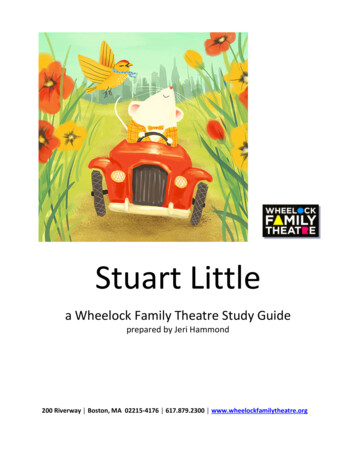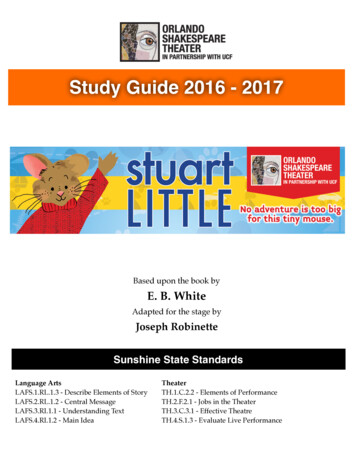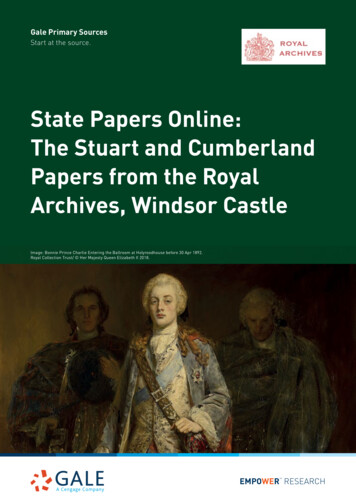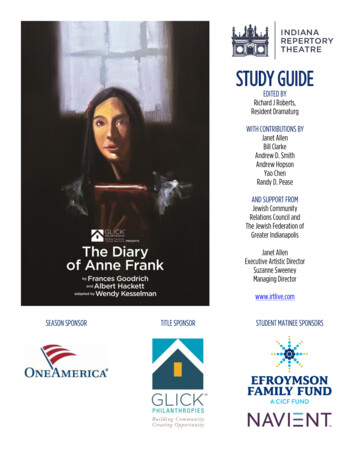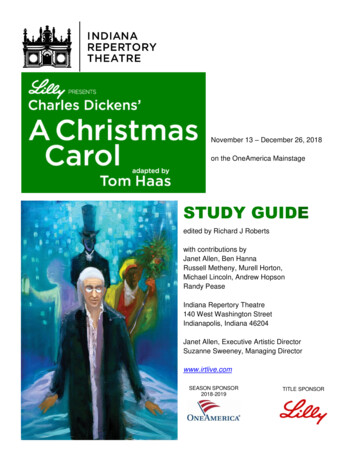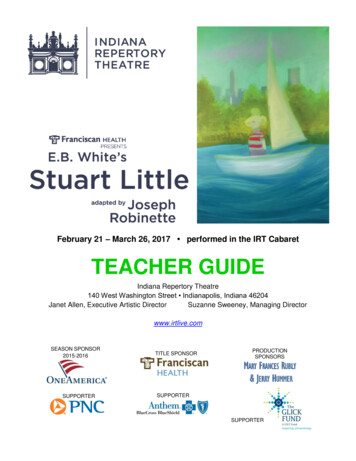
Transcription
February 21 – March 26, 2017 performed in the IRT CabaretTEACHER GUIDEIndiana Repertory Theatre140 West Washington Street Indianapolis, Indiana 46204Janet Allen, Executive Artistic DirectorSuzanne Sweeney, Managing Directorwww.irtlive.comSEASON SPONSOR2015-2016TITLE SPONSORPRODUCTIONSPONSORSMARY FRANCES RUBLY& JERRY HUMMERSUPPORTERSUPPORTERSUPPORTER
2 IRTE. B. White’sStuart Littleadapted by Joseph RobinetteHow could a little boy, who is also a mouse, survive in a large world of humans, boat races, family pets,and stray dogs? With a tenacious heart, Stuart does exactly that – and more. Borne from the mind of E.B.White in his first children’s novel, Stuart Little, our small and loving hero makes friends with Margalo thebird and defends her from the sinister feline, Snowbell, while captaining sailboats and navigating thedangers of rolling window shades.White once wrote that he came up with Stuart Little while dreaming in a railway sleeping car about a tinyboy who acted rather like a mouse. And, rather like a young boy, this mouse works his way through theworld with a heart for adventure and companionship. Coming to life on stage, this classic children’s storybrims with invention and imagination, and will encourage young audiences to problem solve beside oursmall hero to see the world with new eyes. Stuart teaches young and old that there is something to explorearound every corner and that the possibility for friendship and family stretches over us all, whetherfeathered or furred, small or large, human or mouse.Recommended for students in grades Pre-K through 3Themes & TopicsFriendship, Adventure, Differences in Appearance and Ability, Adolescence, Problem-Solving, GenerosityThe performance will last approximately one hour with no intermission.Teacher Guide ContentsWhat Is Theatre?Theatre EtiquetteActivitiesDrama & Language Arts ActivitiesCool DownResource Recommendationscover art by Kyle Ragsdale334152830Education SalesRandy Pease 317-916-4842rpease@irtlive.comOutreach ProgramsMilicent Wright 317-916-4843mwright@irtlive.com
What is Theatre?The most basic needs for a theatrical experience are a story to tell, actors to tell it, and anaudience to hear it. As soon as prehistoric people could communicate with each other, they beganto tell stories around the campfire. As civilization developed, communities gathered for ritualfestivals where stories were told through song, dance, and spoken word. Playwrights fromSophocles to Shakespeare to James Still have written plays that tell stories through dialogue andaction. Taking the playwright’s words from the printed page, actors use their voices, bodies, andcreativity to develop characters that live on stage. Designers create scenery, costumes, lighting,and music that form a unique physical environment for each individual play. The director is theperson who leads this ensemble of artists, making sure that all the various elements andviewpoints come together for a unified statement that creates a satisfying experience for theaudience. When theatre artists bring their best work to the stage, and when audiences receivethat work with open minds and active imaginations, the results can be enlightening, enriching, andentertaining.Theatre EtiquetteWhen your students come to the play, IRT staff will take a moment before the show to remindstudents of what is expected of them:First, we will remind them to remain seated on their bottoms in the carpeted area, and to keeptheir bodies and belongings off of the stage floor. This is so both students and actors are keptsafe, and nobody will trip over anybody!Then we will remind students to listen with their eyes, ears, heart, and body. We want students toenjoy themselves. Remind them that they are welcome to smile and laugh when things are funnyor to frown or say “aww” when those emotions occur. But we must also remember that we aretogether to watch and learn!Just like in school or duringlearning time, we shouldstay focused on the actionof the play.
4 IRTActivities:Reading andRe-Readingthe StoryRead Stuart Little by E. B. White to yourstudents several times. It is available atthe public library. The first time you might read thestory through without interactionfrom the children, but using yourbest expressive reading skills. Themore dramatic you are, the moreyou are preparing the children forthe theatrical experience. Theyare learning what theatre peoplecall active listening: listening withour eyes, ears, hearts, and minds.Use your voice like actors do bychanging your vocal tones. Forexample:o Use the upper range ofyour voice for Margalo.o Use low-pitched sounds forDr. Carey.Another tool to making stories come alive vocally is to use onomatopoeia—words thatimitate the natural sounds of things. Onomatopoeia creates a sound effect that mimics thething described, making the description more expressive and interesting.For example: look at chapter 6 of Stuart Little: “one morning when the wind was fromthe west, Stuart put on his sailor suit and his sailor hat, took his spyglass down from theshelf, and set out for a walk, full of the joy of life and the fear of dogs.”Using onomatopoeia:o “wind” and “west” might be stretched out as “oowwwiiiiiiind” and“oowwweeeeeest” to suggest the sound of wind.o “set out for a walk” might be said very briskly and forcefully to suggest thequality of Stuart’s walking.
o “the joy of life” might be said with a high, cheerful voice, contrasted with “thefear of dogs” in a low, shivering voice, to suggest Stuart’s different emotionsabout these two different things.The second time you are reading through the story, encourage the children to bephysically, vocally, and mentally interactive and engaged with the story.o Have the children repeat how you say words and phrases expressively: “oowwwiiiiiiind” and “oowwweeeeeest”as described above. Help them to notice the sound repetition and rhythm in “Stuart put on hissailor suit and his sailor hat.” Have them mimic your emotional differences on “the joy of life” and “the fearof dogs.”o Lead them to interact physically: Have them scurry like mice: fast, slow, joyously, sadly. Have them pose and stretch like cats. Have them pretend to fly like birds.o Get them to think how the story relates to their own lives: Ask them, “When have you lost a good friend? What did you want to do aboutthat?” Have them think of good laws for Stuart’s book of rules. The third time through the story is about making sure they are following the plot. Knowingthe plot will greatly help the children enjoy the play at the IRT. Feel free to paraphrase thestory while stopping to ask questions about what has happened and what is going tohappen next.o “Why does Stuart get caught in the window shade?”o “Why does Stuart go to visit Dr. Carey in his office?”Each time through the story you can add elements such as using mouse or cat or bird puppets orrepeating a certain physical action each time they hear the word mouse or cat or bird throughoutthe story. Such activities, as you know, build reading comprehension, increase vocabulary, ignitecreativity, and get the body in motion.Reading the story multiple times will not only help the students with comprehension and otherlearning skills, it will also give the children an experience akin to that of the actors they will see inthe play. During rehearsal, the actors will read and work on the script for six hours a day for morethan two weeks.
6 IRTSynopsisA chapter by chapter synopsis of the book Stuart Little by E.B. White provide by Cathy Bridge,Abby Brown, Amy Friedman, and Shelby Phelps from the Learning Curve @ Central Library, 40 ESt Clair St, Indianapolis, IN 46204Chapter 1 – In the DrainIn this first chapter we will all meet Stuart Little. Stuart is the second son of Mr. and Mrs. FrederickLittle. He has a big brother named George. But there is one thing that makes Stuart very differentfrom the people in his family. Stuart is a Mouse! Because he is a mouse he needs special mousesize things. But because he is a mouse he can do things that nobody else in the family can do. Inthis chapter Stuart takes a trip down the bathtub drain to find his mother’s lost ring! So let’s readchapter 1 and meet Stuart Little.Chapter 2 – Home ProblemsIn this chapter Stuart climbs inside his family’s piano. Stuart’s brother George wants to play asong on the piano but one of the piano keys keeps getting stuck. We also find out that Stuart isvery good at finding ping pong balls when they roll off the ping pong table. Stuart can help with somany things. But there is a place in the house that might be trouble – an old mouse hole!Chapter 3 – Washing UpWhen you are mouse like Stuart it is hard to wash up and brush your teeth in a bathroom madefor people. Today we find out how Stuart pulls a string, climbs a rope, and even uses a specialhammer just so he can try to turn on the water in a people size bathroom! What if you had to do allof that? Let’s read and see if it works.Chapter 4 – ExerciseIn this story about Stuart we will meet Snowbell – the Little’s pet cat. Stuart and Snowbell talk toeach other but they are not really best friends. When Stuart gets into some trouble we will see ifSnowbell tries to help. Do you think Snowbell will help Stuart? Let’s read and find out!Chapter 5 – RescuedStuart is still in trouble when we begin this chapter. Snowbell sure didn’t do anything to help whenStuart got trapped in the window shade. Because of Snowbell Stuart’s family thinks that Stuart isdown in the old mouse hole. Today we will find out how Stuart is rescued.Chapter 6 – A Fair BreezeStuart begins a great adventure today. He puts on his sailor suit and sailor hat and walks out thedoor of his house. Stuart is wearing a sailor suit. Do you think he wants to be a sailor? TodayStuart also gets on a big bus and rides the bus all the way to the sailboat pond in Central Park. Atthe pond Stuart meets a man with a sailboat that is just the right size for Stuart! Will the man withthe boat help Stuart be a real sailor? Let’s see what happens.
Chapter 7 – The Sailboat RaceWe found out in the last chapter that Stuart Little loves boats and sailing. In today’s story Stuartsails a toy sailboat named the Wasp in an exciting race on the sailboat pond in Central Park.People run to the pond to watch the race. They cheer for Stuart. Will Stuart’s boat win the race?We will have to read the chapter so we can see what will happen to Stuart Little, the sailor.Chapter 8 – MargaloMargalo is the name of someone we will meet in this chapter – a new friend for Stuart!But first, Stuart gets stuck in the refrigerator for hours, and catches a cold from being in there. Hisparents take care of him by putting him in his little tiny warm bed and giving him good things to eatand drink. While he is getting better, Mrs. Little finds a bird who seems sick, and helps her getbetter also. Do you think the bird is Stuart’s new friend? Stuart really likes his new friend, and isvery brave when he saves her from danger. Let’s read and find out what happens Chapter 9 – A Narrow EscapeIn this chapter Margalo gets to help Stuart.Stuart wants to go ice skating (with the tiny skates made of paper clips his father made for himwhile he was sick.) But when he goes outside he has to hide from a dog. He hides in a garbagecan, and then the garbage truck comes and dumps the can into the truck! Stuart ends up on a bigflat boat called a barge. The garbage on the barge is going to be dumped into the ocean! Luckyfor Stuart, Margalo flies to rescue him! Do you have an idea about how Margalo saves Stuart?Let’s read and find out!Chapter 10 – SpringtimeSnowbell the cat has lots of cat friends in the neighborhood. It’s spring time and the weather isnice for going outside. Snowbell goes out and visits with one of her cat friends, and they talk aboutwanting to hunt for birds. Uh-oh, Margalo is a bird, isn’t she? Another bird (a pigeon) hears thecats talking and leaves Margalo a note warning her that the Angora cat is going to try to catch her.Margalo flies away! Margalo flies north because that is what many birds do in the spring. We seemore birds in the spring and summer than in the winter, don’t we?Chapter 11 – The AutomobileThe Littles look for Margalo, but they cannot find her because she flew away. Stuart is very sadthat his friend Margalo is gone. Stuart decides to leave home and go look for Margalo. Do youremember Stuart’s friend Dr. Carey who has the sail boat? Dr. Carey gives Stuart a little car, justthe right size for Stuart to drive! Stuart wrecks the car the first time he drives it. Don’t worry, Dr.Carey will fix it up.Chapter 12 – The SchoolroomAt the beginning of chapter 12 Stuart drives off in his little car to look for Margalo. Stuart meets aman who is in charge of the schools in a small town. One of the teachers is not there, andbecause Stuart likes to be helpful he volunteers to be the substitute teacher that day. Thestudents have an interesting and unusual day with Stuart compared to their usual teacher. They
8 IRTdiscuss things like having a law against being mean, and to remember to enjoy summer time. Doyou think the students enjoyed having a different teacher for a day?Chapter 13 – Ames’ CrossingStuart stops in a very nice town to get something to drink. When we hear about the town, itsounds like a very nice place to visit. He sees a girl who is as small as he is! Her name is Harriet.He writes her a letter asking if she would like to paddle a canoe on the river with him. Do you thinkStuart is happy to meet someone just his size? The only problem is, he has to find a tiny canoe!The store has a little canoe, and he can use spoons for paddles. He is all set to meet Harriet.Chapter 14 – An Evening on the RiverStuart gets the canoe all fixed and ready for a nice ride on the river. (Show a picture of a canoe.Talk about how it is very quiet to paddle a canoe, compared to a noisy motor boat.) He is nervousabout meeting Harriet – he wonders what she will be like. Harriet comes to Stuart’s camp site onthe river. When they go to get the canoe, it is gone! When Stuart finds the canoe it is wreckedbecause someone has been playing with it. Stuart is very disappointed that he and Harriet cannotgo in the canoe. Harriet has some ideas to do something else like go fishing, or go to a dance atthe country club, but Stuart does not want to do anything else. Why doesn’t Stuart want to doanything else? It starts to rain and Harriet goes home.Chapter 15 – Heading NorthThe next day Stuart puts gas in his little car and is ready to continue his search for Margalo. Stuarttalks to a man who climbs telephone poles to repair the lines. Do you think you could see far awayfrom the top of a telephone pole? The man describes the beautiful trees, and lakes and animalshe has seen when he has travelled. (Look at pictures of nature and talk about taking a naturewalk.) Stuart drives away on the road that goes north. (Look at a map and discuss directions.)Stuart knows he has a long way to go, but he “somehow felt he was headed in the right direction.”I think that means he will find Margalo someday! What do you think?
Activitiesfor before, after, and beyond seeing the playShow and TellHave the children bring in something to share about themselves with their fellow classmates andteachers. Actors do this in acting classes. They share about their characters in acting exercisesand about their personal selves in journals, rehearsals, and acting exercises.Have each child stand up and talk about why a certain food or clothing item he or she brought is afavorite. They can create “My Favorite Things” boards using photographs and pictures frommagazines, then talk about a few things on the board and why they are favorite things to wear,eat, do, make, etc. Stuart Little has his blue suit that his mother made for him!o Try to have the other children look at the child who is sharing while they are listening to thatchild. This teaches the children a skill they will need when they come to the theatre. In thetheatre we call this giving focus. Remind students about eye contact, movement, andnoise, and what that means whenyou’re engaging in activelistening.o Ask each child questions abouthis or her item: Why do you like thatsweater?How long have you had it?Do you remember whogave it to you?Was it a birthday, holiday,or other gift?Is it new or old?Who goes with you to themovies?Does your grandmother letyou help her when shebakes your favoritecookies?
10 IRTActivitiesDiscussionTalk with the children about stories, books, and movies where animals are anthropomorphized,given human characteristics and actions. What is the difference between real animals (in nature,in the zoo, or your pets) and fictional animals (in story books such as Stuart Little, Charlotte’sWeb, The Tale of Peter Rabbit, The Velveteen Rabbit, or Curious George, or in movies such asOver the Hedge, Ice Age: The Meltdown, The Muppet Movie, Kung Fu Panda, and FlushedAway)? Here is an article to help you prep your discussion with your re/samplefiles/journals/la/la0813animals.pdfTalk with the children about books and movies where both animal and human characters areadventurous, mischievous, or cause havoc on others. Beyond Stuart Little, you might use Click,Clack, Moo: Cows That Type by Doreen Cronin, Knuffle Bunny: A Cautionary Tale by Mo Willems,The Day the Crayons Quit by Drew Daywalt or Curious George by H. A. Rey.What does Stuart do to help his family?What does Snowbell do to trick Mr. & Mrs. Little?When does Stuart use his brains to get out of difficult situations?When does he use his physical skills? Why is it important to develop both?In going to find Margalo, who helps Stuart on his way?Do you think he could have made it without their help?Why is it good to help others from time to time?What could people do with all the pancakes Curious George made?Curiosity is both good and worrisome. Give the children a couple of examples of both.The cows had some concerns so they told the farmer about them. Is this a good thing?Were some of the things the cows wanted silly?When you have concerns, you can tell and they will help.Let’s talk about a fun adventure you went on. Did you make any friends on your adventure?Post-Show Discussion Questions for Stuart Little What was the name of Stuart Little’s brother? Was he the younger or the older brother? Didthese two brothers like each other? What happened in the play that showed how they feltabout each other? Do you think George felt like he got as much attention from their parentsand everyone after Stuart was born? How would you describe the personality of Stuart Little? Was he helpful or mean? Did heget along with others? Did he sit around the house and do nothing or was he physicallyactive? What happened in the play and the book to support your choice? What advantages are there to being a mouse? What type of things was Stuart able to helphis family with? What was the family’s household pet and what was his name? When Stuart’s mother sees Stuart’s towel and toothbrush near the mouse hole why doesshe gets upset?
How did Stuart’s parents find him after they thought he was lost down the mouse hole?Would say that Snowbell was a bit jealous of Stuart? What did Snowbell do that showedthat he was or was not jealous?Was the Bureau of Missing Persons any help to the Little family in finding Stuart? Why orWhy not?Stuart Little is in good physical shape! What types of physical activity does he dothroughout the play?What is Stuart’s best friend’s name? What is she?How did Stuart feel about Margalo when he met her?How did Stuart save Margalo from Snowbell the first night she stayed at the Little house?It isn’t nice to listen in on other people’s conversation, but what were the cats, Angie andSnowbell, talking about that made the Pigeon decide that she HAD to listen in on what theywere talking about?Which Cat was the instigator, the one that really started the trouble that made Margalohave to leave the Little house?How did the Pigeon warn Margalo that she was in danger?How did Stuart feel when he discovered Margalo was gone?When Stuart set off from home to find his friend, who did he stop to visit for help on whereto start looking for Margalo? Who else was there to help and what were they doing?What do you think happened to Stuart Little at the end when he drove north to findMargalo?Is being different from others okay? Why or why not?One of the themes in the play is friends helping friends. What type of things did Stuart do tohelp his friends and what type of things do you do to help your friends?Should you strive to do your best in the activities you participate in? Why or why not?In what ways can we hold on to good memories? (Photo albums, journaling, telling stories,etc.)How does jealousy lead us to actions we come to regret?Stuart Little is nice to others. What are ways all of us can be kind to our fellow citizens?ActivitiesWriting and/or DrawingAfter seeing the play, have your students write or draw a message to the cast. It could be a thankyou, or a note to tell the actors about their favorite part of the play.Younger students might make a drawing and dictate to the teacher what they’d like to say.Older students might write a sentence or two about what they remember most from the play, orhow they felt during or after the play, and why.Draw pictures of the scenes from the play with a simple description to explain the action.Examples: Stuart doing chin-ups on the window shade, Stuart ice skating, Stuart driving themodel carActivities
12 IRTMultiple Choice QuestionsFeel free to make these more challenging for upper grade levels.1. In what city does the Little family live?A. MiamiB. Hong Kong C. New York2. What is the name of the boat Stuart sails when he wins the boat race?A. The Willow B. The WomrathC. The Wasp3. What does Margalo love to do?A. WhistleB. DanceC. Play the flute4. Twice in the play Stuart gets chased by what type of animal?A. A foxB. A dogC. A rat5. Who does the Little Family call for help when they can’t find Stuart?A. Bureau of Missing PersonsB. Bureau of Missing RodentsC. The Circus6. What was the gray cat’s name that told Snowbell that he should go after Margalo and eat her?A. BobB. SnugglesC. Angie7. What type of doctor is Dr. Carey?A. A pediatrician B. A dentistC. A podiatrist8. In what direction did Margalo fly to keep herself and Stuart out of harm’s way?A. EastB. SouthC. North9. At the end of the play, what do Stuart and Mrs. Little say is important, VERY important?A. PizzaB. Ice CreamC. Eggplant10. At the end of the play, Stuart Little and his brother George ask you to “never forget yourWHAT?”A. WintertimesB. SpringtimesC. SummertimesAnswer Key: 1C, 2C, 3A, 4B, 5A, 6C, 7A, 8C, 9B,10C
ActivitiesAdditional Activities from Learning CurveOther Stuart Little Curriculum Activity Suggestions for 4-5 year-old preschool provide by CathyBridge, Abby Brown, Amy Friedman, and Shelby Phelps from the Learning Curve @ CentralLibrary, 40 E St Clair St, Indianapolis, IN 46204These aren’t lesson plans but are activity/unit ideas to incorporate about Stuart Little. Tailor thesesuggestions to what best fits your classroom and student interest.Before seeing the play and as you read the story, introduce the students to mice. What do theyeat? How do they behave? Read stories/sing songs and rhymes about mice.TransportationStuart loves boats! He pilots a sailboat and a canoe in the book. Make boats out of tinfoil or othermaterial with a paper sail and run boat races at a water table! This could also segue into anexploration of wind activities. If water isn’t available, Stuart also loves to drive cars and fly on abird.Problem SolvingAs you will see in the play and talk about the story, Stuart is a mouse but behaves like a personjust like us. It’s not easy for him to do some of the things we do every day as humans. In chapter 3Stuart brushes his teeth, and it’s a big ordeal! Can you think of a way to help Stuart turn on thefaucet? What about some other everyday situations? If Stuart was at your house, what would youserve his food on? Remember he’s a teeny tiny mouse- people plates and forks would be too bigfor him! How would he get into his seat at the dinner table? What could you build to help him dosome of your favorite things? Try to use specific examples to help students picture scenarios andcome up with solutions. These can be acted out in dramatic play, or be an art/science activity, oreven a discussion at carpet/circle time.ExtensionIf you have a plush mouse, consider sending “Stuart” home for a weekend/the night (teachers canset the period of time) with a student each week/day in a basket with a journal. Ask students towrite what they did with Stuart, and how they accommodated him in their family activities. Did youfeed him? Clothe him? Read him a story? When they return with the mouse, have the studentshare with the class. Then Stuart goes home with another student.LibraryStuart loves to read and write! Put him in your library and ask students to read to him! If thestudents have journals, ask them to write Stuart a story and read it to him. Include Stuart in yourRead Alouds.
14 IRTAlliterationThe book uses alliteration (page 33). Have fun making up nonsense words or thinking of wordsthat make the same sound. Pick a letter sound per day or more, depending on the ability of yourclass.OppositesEverything is BIG in Stuart’s world and he is very little. This is a great time to introduce oppositesand sizes.A rhyme titled, This is Big Big BigThis is big, big, big, (stretch out arms)This is small, small, small (brings arms in)This is short, short, short (lower arms)This is tall, tall, tall (reach arms high)This is fast, fast, fast, (roll fists fast!)This is slow, slow, slow (roll fists slow)This is yes, yes, yes, (nod)This is no, no, no (shake head)City and CountryHave some nonfiction books and pictures that are about the city and country side. Have childrendiscuss what you find in the city and what you find in the country. Use sorting activities such aspictures of cities and country sides for a center activity. What transportation do you use in thecity? (subway, train, taxi, car) what do you use in the country? (boat, horse, car etc.)Special thanksto TheLearningCurve @Central Libraryfor theirassistance inpreparingthesematerials!
Drama and Language Arts Activitiesfor before, after, and beyond seeing the playSeveral of these activities will be led by IRT teaching artist(s) when working with your students.Feel free to ask your teaching artist any questions you have about content, execution, supplies, orlogistics. We hope you will use these activities with your students beyond this collaboration.Yes, Let’s!This game has manyvariations, but foryounger children wesuggest that you startout as the leader andthen guide them ingiving actions and ideas.As “The Ooey GooeyLady” has said in herpresentations, thisactivity can go on forquite a while if youstretch your creativity.Have the children standaround the room with enough physical space that they can move their arms and legs and notbump anybody. Teach them two phrases: Whoever starts the action says, “Let’s ” then says and does an action at the same time. The group responds, “Yes, let’s!” and then does the action.For example:o You might start by saying, “Let’s all stand up” and the group would then say, “Yes, let’s!”as they stand up.o Then you might say, “Let’s look at the stars in the sky,” and then the group would say,“Yes, let’s” while they look up as if looking at the stars, pointing to them and making “oh”and “ah” sounds.o You might elaborate the action by saying, “Look there is the north star shining bright”and pointing at it and having the children point at it as well.o Then go on to the next prompt, which could be something like, “Let’s march up themountain to get a better look.” And the group then says enthusiastically, “Yes, let’s.”
16 IRTSome helpful tips: This is an activity where the actions can be random (Let’s swing our arms, act like amouse, brush our teeth) or you can suggest actions in sequence to guide the children on ajourney. Eventually you want to get the game going so well that the children are giving actions.Encouraging them to say, “Let’s catch fireflies” or any action they can think of. To take it further in learning language, have the children repeat the whole sentence. “Let’sjump up and down.” “Yes! Let’s jump up and down!” You might want to create a signal of some sort that will stop the action so you can moveonto the next one. If the activity is getting stuck, side coach the children by asking what types of activities theydo every day. What types of activities do they see adults doing? What activities do you doin the kitchen? These prompts will help the children and you to come up with more ideas tokeep the game going. Offer imaginative prompts as well as reality-based actions. For example: Let’s fly to themoon, let’s be fairies and spread morning dewdrops, let’s be vegetable seeds and growinto tall corn stalks, let’s be monsters and eat everything in the house .For older children, this game can be turned into a guessing game: Someone does an action silently; when another person has figured out what they aredoing, they say, “Yes, let’s comb our hair.” The person who guessed what the other person was doing is the next person to startpantomiminganother action forsomeone in thegroup to guess.This activity is great forreinforcing positiveattitudes, supporting theideas of others, learningverbs, creativity, repetition,and getting physical.
Drama & Language Arts Activities:Dramatic PlayThe core of these activities is to help the children be physical while they tell stories and to use andextend their vocabulary, grammar, and creativity.Making Up a S
A chapter by chapter synopsis of the book Stuart Little by E.B. White provide by Cathy Bridge, Abby Brown, Amy Friedman, and Shelby Phelps from the Learning Curve @

